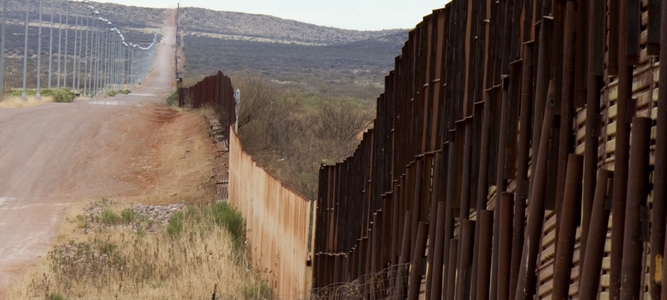 Not surprisingly, the issue of border security is emerging as the biggest stumbling block to passage of the immigration reform bill now moving through the Senate. Conservative opponents of reform are refusing to support any measure that would grant legal status to unauthorized immigrants already in the country without first achieving that most nebulous of goals: “securing the border.” Yet the calls of these critics for “enforcement first” conveniently overlook the fact that the United States has been pursuing an “enforcement first” approach to border security for more than 20 years—and it has yet to work.
Not surprisingly, the issue of border security is emerging as the biggest stumbling block to passage of the immigration reform bill now moving through the Senate. Conservative opponents of reform are refusing to support any measure that would grant legal status to unauthorized immigrants already in the country without first achieving that most nebulous of goals: “securing the border.” Yet the calls of these critics for “enforcement first” conveniently overlook the fact that the United States has been pursuing an “enforcement first” approach to border security for more than 20 years—and it has yet to work.
Nevertheless, Sen. Marco Rubio (R-FL), a key member of the “Gang of Eight,” is hoping to placate conservative critics by proposing a change to that part of the legislation which would grant the Department of Homeland Security (DHS) the responsibility for crafting a border security plan. Under Rubio’s proposal, that authority would come to rest with Congress instead. According to Rubio, this change is necessary because “people do not trust this administration and the federal government in general to do the law.”
Rubio’s statement ignores a key fact: every presidential administration of the past two decades—including that of President Obama—has presided over dramatic increases in border-enforcement spending and manpower. Since the last major legalization program for unauthorized immigrants in 1986, the federal government has spent an estimated $186.8 billion on immigration enforcement. For instance:
- Since 1993, when the current strategy of concentrated border enforcement was first rolled out along the U.S.-Mexico border, the annual budget of the U.S. Border Patrol has increased from $363 million to more than $3.5 billion.
- Since the creation of DHS in 2003, the budget of U.S. Customs and Border Protection (CBP)—the parent agency of the Border Patrol within DHS—has increased from $5.9 billion to $12 billion per year. On top of that, spending on U.S. Immigration and Customs Enforcement (ICE), the interior-enforcement counterpart to CBP within DHS, has grown from $3.3 billion since its inception to $5.6 billion today.
- The number of Border Patrol agents doubled from 10,717 in Fiscal Year (FY) 2003 to 21,394 in FY 2012. The number of CBP officers staffing ports of entry grew from 17,279 in FY 2003 to 21,423 in FY 2012. And the number of ICE agents devoted to Enforcement and Removal Operations increased from 2,710 in FY 2003 to 6,338 in FY 2012.
Not only has the federal government consistently increased spending on border enforcement, it has also met the border-security benchmarks laid down in the three immigration-reform bills introduced in the Senate since 2006. As the American Immigration Lawyers Association explains in a January 2013 analysis, the “benchmarks” for border security specified in the 2006, 2007, and 2010 immigration-reform bills in the Senate have been largely met. The requirements in the bills for more border-enforcement personnel, border fencing, surveillance technology, unmanned aerial vehicles, and detention beds have been fulfilled. Yet congressional opponents of immigration reform want to continually create new metrics to replace the old ones, moving the finish line further and further away.
It is likely that Sen. Rubio feels politically obliged to placate opponents of the Senate immigration reform bill by moving to the right on border enforcement. From a policy perspective, this is political theater, because there is no basis for demanding that our dysfunctional immigration laws be fully and successfully enforced as a precondition for reforming those laws. Enforcement with reform is the only effective way to repair a broken immigration system and enhance border security. In contrast, the “enforcement first” approach would more accurately be called “enforcement forever,” because there is no end in sight.
FILED UNDER: Department of Homeland Security, enforcement, Executive Branch, immigration legislation


